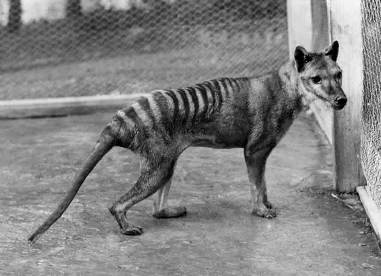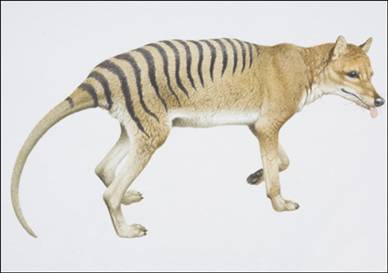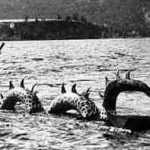Aka: Tasmanian tiger or Tasmanian wolf
Description
The creature is half wolf and half tiger, with a head like a large dog’s, hindquarters like a hyena’s, and tiger stripes covering only the rear half of its body ending with a long, rigid tail. The mature Thylacine ranged from 100 to 130 cm (39 to 51 in) long, plus a tail of around 50 to 65 cm (20 to 26 in).[26] The largest measured specimen was 290 cm (9.5 ft) from nose to tail. It also has a pouch like a kangaroo’s, except that the pouch opens backwards.
Origin
A carnivorous marsupial, the thylacine was exclusively native to Australia. The species seems to have been driven off the continent’s mainland about 10,000 years ago, probably because of a losing battle against dingoes. The thylacine found refuge on the island of Tasmania, which was once connected to the continent by a land bridge, and became the only place on Earth where thylacines were found.
Sightings
In the 19th century, European settlers on Tasmania considered the thylacine as a destructive menace responsible for slaughtering sheep and other livestock. Both government and private agencies offered bounties to have them killed.
Thylacines were exterminated at a rapid pace, with the animal’s strange appearance making it an easy target. By the early 20th century, the thylacine was nearly wiped out and no longer a significant threat, and yet the killing continued.

Bounties on the animal were officially ended in 1909, but the thylacine was still being hunted down as late as 1930. In 1933, the last known specimen, Benjamin, was captured and kept at the Hobart Zoo until he died 3 years later.
The Australian Rare Fauna Research Association reports having 3,800 sightings on file from mainland Australia since the 1936 extinction date, while the Mystery Animal Research Centre of Australia recorded 138 up to 1998, and the Department of Conservation and Land Management recorded 65 in Western Australia over the same period. On the mainland, sightings are most frequently reported in Southern Victoria
Despite the vast number of sightings in wild areas across Tasmania, and discoveries of alleged thylacine tracks, no concrete evidence of the species’ survival has yet been produced. In 1985, Kevin Cameron produced a series of alleged photographs of a living thylacine taken in Western Australia.
These photos are generally judged to be of a fake or stuffed thylacine. The thylacine has also been recently spotted alive as far as Indonesia and England.
The Australian Museum in Sydney began a cloning project in 1999. The goal was to use genetic material from specimens taken and preserved in the early 20th century to clone new individuals and restore the species from extinction. In 2008, a group of researchers successfully sequenced the complete thylacine mitochondrial genome from two museum specimens. Their success suggests that it may be feasible to sequence the complete thylacine nuclear genome from museum specimens. Their results were published in the journal Genome Research in 2009.









